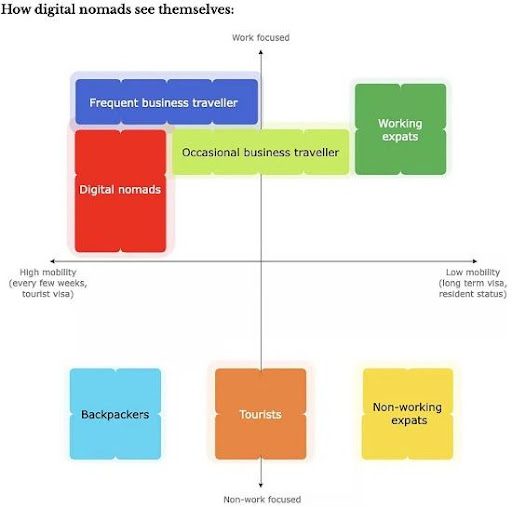|
|
Pre-pandemic, people generally agreed that there were three types of digital nomads, based on how they earn income. But new research, focused on American workers, conducted by anthropologist Dave Cook and recently published a study in the World Leisure Journal, suggests that there are now five categories of digital nomads.
But is “how they earn” really the most useful way to characterize digital nomads? What about “how they travel”? We think these two elements must be brought together before we can have a truly comprehensive paradigm for discussing the digital nomad lifestyle.
Below we will go through the new digital nomad income categories proposed by Cook, and then suggest some digital nomad categories that should also be considered. Once you have finished reading, let us know what you think about this proposed categorization system.
See the original paper: What is a digital nomad?
Digital Nomad Income Categories
Cook’s model is an update to how digital nomads saw themselves before the pandemic, which is summarized by the graph below.

Freelance Digital Nomads
Freelance digital nomads used to be what most people imagined when they thought of digital nomads. They are people who work for themselves in jobs that don’t require them to be in a specific location, such as programmers, writers, and designers. They might even be people in professions that require them to travel extensively, such as photographers and travel bloggers or vloggers.
Digital Nomad Business Owners
This category of digital nomads used to be called Entrepreneurs but Cook prefers business owners as it is not always easy to draw clean lines between freelancers, solopreneurs, business owners, and entrepreneurs.
What sets Digital Nomad Business Owners apart for Cook is that they probably employ people themselves, probably including some of our Freelance Digital Nomads, and have to deal with issues such as business infrastructure and product inventory. This usually, but not always, requires the maintenance of a “home base” for the business.

Salaried Digital Nomads
Salaried Digital Nomads are basically remote workers that are employed by a specific company, but they are location independent and choose to travel while working. The number of Salaried Digital Nomads in the United States is estimated to have increased by 42% between 2020 and 2022.
While an increasing number of companies are enabling their employees to work remotely post-pandemic, managing anywhere workers that could be located anywhere in the world is a huge challenge that Human Resources departments are yet to resolve.
Read our guide to how to create the perfect remote work policy here.
Experimental Digital Nomads
Cook has coined the term Experimental Digital Nomads for people who have started working and traveling at the same time, but they are not yet earning enough to support their digital nomad lifestyle. For example, they may have recently left their salaried position to go freelance and travel, but they do not yet have a sufficient client base to fully support their costs.
According to his research, most Experimental Digital Nomads will give up their lifestyle within 12 months for financial reasons.
Armchair Digital Nomads
Armchair Digital Nomads are the opposite of Experimental Digital Nomads in that they are working freelance or remotely and earning a decent income, but they have not yet started traveling, though they are considering it.
This is the hardest group to track as there is very little historical data about these people and what they end up doing.
This is an interesting new category as it defies one of the fundamentally accepted definitions of a digital nomad on that they visit at least three locations a year that are not their home or that of a friend or family member.

Research Themes
If you read Dave Cook’s full research, he suggests that research into these different groups in the future should focus on six main themes.
- Autonomy over mobility – Can they choose when to travel, how often, and for how long.
- Homebase practices – Do they maintain a home base and how frequently do they move?
- Domestic vs transnational travel – Do they pursue international travel or prefer domestic travel?
- Legal legitimacy – Are they technically allowed to live and work where they are based?
- Work-life balance
- Coworking space usage – Do they use coworking spaces as a resource when traveling?
He suggests that these are the necessary elements to better understand the motivation, viability, and impact of digital nomads.
Digital Nomad Travel Categories
While Dave Cook’s Digital Nomad categories are certainly useful, we think that studies should look not only at how people work but also at how they travel to understand the full spectrum of digital nomadism. Perhaps each digital nomad could be positioned on a chart with these two factors as axes.
We suggest some of the following as potential categories for digital nomads based on their approach to travel.
Full-Time Digital Nomads
This is the person who leaves their hometown, and probably their home country, with the intention of traveling more or less continuously for the foreseeable future. These types of nomads tend towards slowmadism, spending a little bit more time in each place rather than picking up sticks and making a move every week or so.
Fixed-Period Digital Nomads
These are individuals who have decided to travel for a fixed period of time, perhaps one to two years, before “settling down” somewhere. Of course, their plans may change, and they may choose to become Full-Time Digital Nomad. These are the traveling workers who tend to move around more often as they have a fixed deadline to cross off all the destinations on their bucket lists.
Part-Time Digital Nomads
Not all digital nomads choose to travel continuously. There are some that may choose to travel for three to six months of the year while spending the rest of their time at their “home base”. This is not uncommon for residents of colder countries, who may “head south” for the winter for better temperatures. It is also not uncommon for those with young families, as it allows them to take advantage of the long school holidays.
Anyone who takes “hush trips” might also be considered to fall into this category.

Digital Expats
Many people may say that expats don’t belong on the digital nomad list, but it is a blurry line. Now that many countries are offering digital nomad visas that allow remote workers to stay in a country for between one and five years, some digital nomads are getting more settled and encroaching on the expat lifestyle.
The key difference is that while expats usually work within the local economy in which they live, digital nomad visas explicitly block this and demand that remote workers have an income that comes from outside the country. For more info, see the article we covered on digital expats.
Blending Digital Nomad Categories
We think that blending these two different categories offers the best insight into understanding how digital nomads live and work. It would enable us to distinguish Full-Time Digital Nomad Business Owners, from Part Time Salaried Digital Nomads, and Digital Nomad Freelancer Ex-Pats.
Of course, the whole point of the digital nomad lifestyle is to live life by your own rules and refuse to be pushed into convenient categories. That is why it will always be challenging to develop a categorization system that can characterize all digital nomads.
Do you agree with the categorization? Which category suits you the most?











